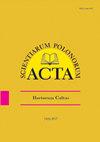The changes in fatty acid profile during senescence and methyl jasmonate-induced senescence of Ginkgo biloba leaves
IF 0.7
4区 农林科学
Q4 HORTICULTURE
引用次数: 0
Abstract
The present study describes changes in fatty acid (FA) composition in Ginkgo biloba leaves subjected to senescence and to senescence induced by methyl jasmonate (MeJA). Green leaves were treated with MeJA in lanoline on the abaxial or adaxial side of the leaf blades. After three weeks of treatment, leaf blades and petioles were collected separately for FA analyses. Additionally, petioles and leaf blades were sampled for analyses before the experiment and after 6 weeks when leaf senescence was occurring. Linolenic (C18:3) and palmitic (C16:0) acids appeared to be the quantitatively most abundant FA in leaf blades and petioles of G. biloba. Both leaf senescence and that induced by MeJA caused a decrease in unsaturated FA content, especially linolenic (C18:3). However, the decrease in C18:3 acid in both leaf blades and petioles was greater when MeJA was applied to the abaxial side than when it was applied to the adaxial side of leaves or during senescence. At the same time, saturated FA content increased, resulting in a significant decrease in the ratio of total unsaturated to saturated FA. Since leaf fatty acids occur mainly as components of cell membranes, changes in their composition may have a crucial effect on membrane function and stability, as pointed out in the discussion of the results.银杏叶片衰老过程中脂肪酸谱的变化及茉莉酸甲酯诱导的衰老
本文研究了衰老和茉莉酸甲酯(MeJA)诱导下银杏叶片脂肪酸组成的变化。在绿叶叶片背面和正面分别用羊毛脂加MeJA处理。处理3周后,分别采集叶片和叶柄进行FA分析。此外,在实验前和6周后叶片衰老时,采样叶柄和叶片进行分析。亚麻酸(C18:3)和棕榈酸(C16:0)在叶柄和叶片中含量最多。叶片衰老和MeJA诱导的叶片衰老均导致不饱和脂肪酸含量下降,尤其是亚麻酸含量(C18:3)。但是,叶柄和叶片中C18:3酸含量的减少,在叶片背面施用MeJA比在叶片正面施用或衰老期间施用MeJA更大。同时,饱和FA含量增加,导致总不饱和FA与饱和FA的比值显著降低。由于叶片脂肪酸主要作为细胞膜的组成部分出现,因此其组成的变化可能对细胞膜的功能和稳定性产生至关重要的影响,正如讨论结果所指出的那样。
本文章由计算机程序翻译,如有差异,请以英文原文为准。
求助全文
约1分钟内获得全文
求助全文
来源期刊
CiteScore
1.30
自引率
14.30%
发文量
61
审稿时长
4-8 weeks
期刊介绍:
In Acta Scientiarum Polonorum Hortorum Cultus we publish original research papers and review articles containing new and significant information on broad aspects of horticulture and related disciplines. The papers are published in English only, in six issues yearly.

 求助内容:
求助内容: 应助结果提醒方式:
应助结果提醒方式:


